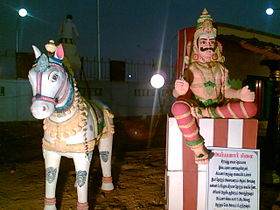Aiyanar
- Aiyanar
-

Divinité locale
Aiyanar, avec son cheval.
Aiyanar (orthographié également Ayyanar, Ayanar ou Iyenar) (tamoul : ஐயனார்) est un dieu local, un « dieu de village » de l'Inde du Sud, vénéré principalement dans l'État du Tamil Nadu. Il est adoré en tant que divinité gardienne, qui protège les villages ruraux. Ses prêtres ne sont en général pas des Brahmanes, et appartiennent principalement à la caste des potiers, mais des membres d'autres castes peuvent aussi officier dans ses temples. Les temples de Aiyanar sont généralement flanqués de statues gigantesques et colorées qui le représentent, lui et ses compagnons, chevauchant des chevaux ou des éléphants.
Il existe plusieurs théories sur les origines de cette divinité, ainsi que sur l'étymologie de son nom. Il est associé au dieu Aiyanayake par les populations cingalaises du Sri Lanka.
Annexes
Références
Bibliographie
(en) Julia Leslie, Roles and rituals for Hindu women, Motilal Banarsidass Publ., 1992 (ISBN 978-81-208-1036-5), « Fecundity Rites »
Articles connexes
Liens externes
Sur les autres projets Wikimedia :
Wikimedia Foundation.
2010.
Contenu soumis à la licence CC-BY-SA. Source : Article Aiyanar de Wikipédia en français (auteurs)
Regardez d'autres dictionnaires:
Aiyanar — Aiyanar is a demigod represented as a warrior mounted on a horse who is the night guardian in Tamil Nadu. He is sometimes accompanied in iconography or painted representation by other martial figures and dogs. He patrols the boundar ies of… … Encyclopedia of Hinduism
Ayyanar — Aiyanar, deidad hindú del sur de la India con su caballo blanco. Ayyanar o Aiyanar es un dios local tamil, un dios de pueblo del sur de la India, venerado principalmente en el estado de Tamil Nadu. Es adorado como divinidad guardiana que protege… … Wikipedia Español
Ayyanar — ( ta. ஐயனார் or அய்யனார்) is a regional Tamil male deity who is popular among the rural social groups of South India, specifically Tamil Nadu. In the old Tamil literature he is mentioned as Sathanar and in Vedic stories, Ayyanar is considered as… … Wikipedia
Namakkal — This article is about the municipality in Tamil Nadu, India. For its namesake district, see Namakkal district. Namakkal … Wikipedia
Mohini — This article is about an avatar of the Hindu God Vishnu. For other uses, see Mohini (disambiguation). Mohini A sculpture of an eight armed dancing Mohini at the Hoysaleswara Temple in Halebidu … Wikipedia
Marcus Cornish — Nationality English Field Sculpture Training Camberwell School of Art, Royal College of Art Marcus Cornish is a contemporary British sculptor. After obtaining a First Class Ho … Wikipedia
List of Hindu temples — Hindu temple is called Mandir or Kovil or Devasthanam or Dega (Nepal Bhasa) or Ambalam (Malayalam) or other words in different Indian languages. It is usually dedicated to a primary deity, called the presiding deity, and other deities associated… … Wikipedia
Chentu — Type Whip Place of origin India A chentu (Tamil: செண்டு) is a horse whip which looks like a crooked stick, and is a typical attribute of Aiyanar, Krishna in his aspect as Rajagopala, and Shiva with Nandi. The attribute of chentu, which… … Wikipedia
Gaja — (a Sanskrit word for elephant) is one of the significant animals finding references in Hindu scriptures and Buddhist and Jain texts. In general, a gaja personifies a number of positive attributes including abundance, fertility and richness;… … Wikipedia
Religion in ancient Tamil country — The people of the ancient Tamil country of the Sangam age (ca. 200 BCE to 200 CE), practiced three main religions: Hinduism, Buddhism and Jainism. The society displayed tolerance towards all religions, as the monarchs themselves openly encouraged … Wikipedia

